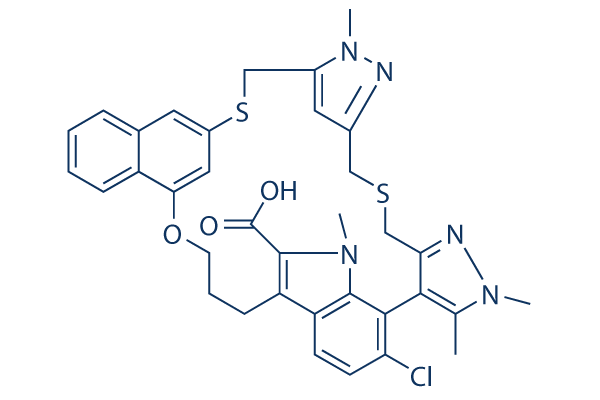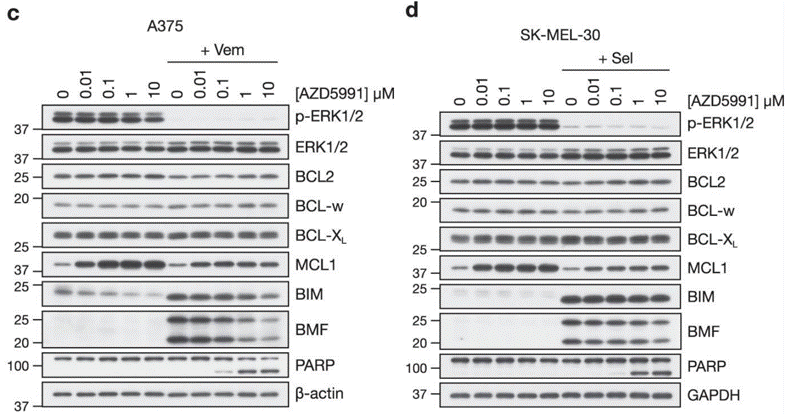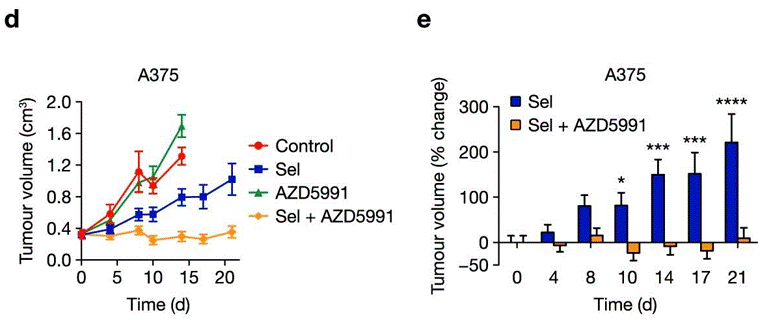
- Bioactive Compounds
- By Signaling Pathways
- PI3K/Akt/mTOR
- Epigenetics
- Methylation
- Immunology & Inflammation
- Protein Tyrosine Kinase
- Angiogenesis
- Apoptosis
- Autophagy
- ER stress & UPR
- JAK/STAT
- MAPK
- Cytoskeletal Signaling
- Cell Cycle
- TGF-beta/Smad
- Compound Libraries
- Popular Compound Libraries
- Customize Library
- Clinical and FDA-approved Related
- Bioactive Compound Libraries
- Inhibitor Related
- Natural Product Related
- Metabolism Related
- Cell Death Related
- By Signaling Pathway
- By Disease
- Anti-infection and Antiviral Related
- Neuronal and Immunology Related
- Fragment and Covalent Related
- FDA-approved Drug Library
- FDA-approved & Passed Phase I Drug Library
- Preclinical/Clinical Compound Library
- Bioactive Compound Library-I
- Bioactive Compound Library-Ⅱ
- Kinase Inhibitor Library
- Express-Pick Library
- Natural Product Library
- Human Endogenous Metabolite Compound Library
- Alkaloid Compound LibraryNew
- Angiogenesis Related compound Library
- Anti-Aging Compound Library
- Anti-alzheimer Disease Compound Library
- Antibiotics compound Library
- Anti-cancer Compound Library
- Anti-cancer Compound Library-Ⅱ
- Anti-cancer Metabolism Compound Library
- Anti-Cardiovascular Disease Compound Library
- Anti-diabetic Compound Library
- Anti-infection Compound Library
- Antioxidant Compound Library
- Anti-parasitic Compound Library
- Antiviral Compound Library
- Apoptosis Compound Library
- Autophagy Compound Library
- Calcium Channel Blocker LibraryNew
- Cambridge Cancer Compound Library
- Carbohydrate Metabolism Compound LibraryNew
- Cell Cycle compound library
- CNS-Penetrant Compound Library
- Covalent Inhibitor Library
- Cytokine Inhibitor LibraryNew
- Cytoskeletal Signaling Pathway Compound Library
- DNA Damage/DNA Repair compound Library
- Drug-like Compound Library
- Endoplasmic Reticulum Stress Compound Library
- Epigenetics Compound Library
- Exosome Secretion Related Compound LibraryNew
- FDA-approved Anticancer Drug LibraryNew
- Ferroptosis Compound Library
- Flavonoid Compound Library
- Fragment Library
- Glutamine Metabolism Compound Library
- Glycolysis Compound Library
- GPCR Compound Library
- Gut Microbial Metabolite Library
- HIF-1 Signaling Pathway Compound Library
- Highly Selective Inhibitor Library
- Histone modification compound library
- HTS Library for Drug Discovery
- Human Hormone Related Compound LibraryNew
- Human Transcription Factor Compound LibraryNew
- Immunology/Inflammation Compound Library
- Inhibitor Library
- Ion Channel Ligand Library
- JAK/STAT compound library
- Lipid Metabolism Compound LibraryNew
- Macrocyclic Compound Library
- MAPK Inhibitor Library
- Medicine Food Homology Compound Library
- Metabolism Compound Library
- Methylation Compound Library
- Mouse Metabolite Compound LibraryNew
- Natural Organic Compound Library
- Neuronal Signaling Compound Library
- NF-κB Signaling Compound Library
- Nucleoside Analogue Library
- Obesity Compound Library
- Oxidative Stress Compound LibraryNew
- Plant Extract Library
- Phenotypic Screening Library
- PI3K/Akt Inhibitor Library
- Protease Inhibitor Library
- Protein-protein Interaction Inhibitor Library
- Pyroptosis Compound Library
- Small Molecule Immuno-Oncology Compound Library
- Mitochondria-Targeted Compound LibraryNew
- Stem Cell Differentiation Compound LibraryNew
- Stem Cell Signaling Compound Library
- Natural Phenol Compound LibraryNew
- Natural Terpenoid Compound LibraryNew
- TGF-beta/Smad compound library
- Traditional Chinese Medicine Library
- Tyrosine Kinase Inhibitor Library
- Ubiquitination Compound Library
-
Cherry Picking
You can personalize your library with chemicals from within Selleck's inventory. Build the right library for your research endeavors by choosing from compounds in all of our available libraries.
Please contact us at [email protected] to customize your library.
You could select:
- Antibodies
- Bioreagents
- qPCR
- 2x SYBR Green qPCR Master Mix
- 2x SYBR Green qPCR Master Mix(Low ROX)
- 2x SYBR Green qPCR Master Mix(High ROX)
- Protein Assay
- Protein A/G Magnetic Beads for IP
- Anti-Flag magnetic beads
- Anti-Flag Affinity Gel
- Anti-Myc magnetic beads
- Anti-HA magnetic beads
- Poly FLAG Peptide lyophilized powder
- Protease Inhibitor Cocktail
- Protease Inhibitor Cocktail (EDTA-Free, 100X in DMSO)
- Phosphatase Inhibitor Cocktail (2 Tubes, 100X)
- Cell Biology
- Cell Counting Kit-8 (CCK-8)
- Animal Experiment
- Mouse Direct PCR Kit (For Genotyping)
- New Products
- Contact Us
AZD5991
AZD5991 is a macrocyclic MCL-1 inhibitor with sub-nanomolar affinity for MCL-1 (Ki = 0.13 nM). The binding affinity of AZD5991 is about 25-fold lower for mouse Mcl-1 vs. human Mcl-1 but only four-fold lower for rat Mcl-1.

AZD5991 Chemical Structure
CAS: 2143010-83-5
Selleck's AZD5991 has been cited by 16 publications
Purity & Quality Control
Products often used together with AZD5991
AZD5991 and Bortezomib show potent antitumor activity in vivo with complete tumor regression in several models of multiple myeloma and acute myeloid leukemia.
AZD5991 and Venetoclax show potent antitumor activity in vivo with complete tumor regression in several models of multiple myeloma and acute myeloid leukemia.
AZD5991 and Telaglenastat increase apoptosis rate and inhibit cell proliferation in HG-3 and MEC-1 cell lines.
AZD5991 and Selumetinib overcome MEKi resistance in triple-negative breast cancer (TNBC).
Mughees M, et al. Cancer Res (2022) 82 (12_Supplement): 1793.
AZD5991 and Capivasertib cause a reduction of cell viability in PTEN-deficient BC cells.
Other Bcl-2 Products
Related compound libraries
Choose Selective Bcl-2 Inhibitors
Biological Activity
| Description | AZD5991 is a macrocyclic MCL-1 inhibitor with sub-nanomolar affinity for MCL-1 (Ki = 0.13 nM). The binding affinity of AZD5991 is about 25-fold lower for mouse Mcl-1 vs. human Mcl-1 but only four-fold lower for rat Mcl-1. | ||||
|---|---|---|---|---|---|
| Targets |
|
| In vitro | ||||
| In vitro | AZD5991 is a potent and direct inhibitor of Mcl-1 with high selectivity versus other Bcl-2 family proteins. AZD5991 binds directly to Mcl-1 and induces rapid apoptosis in cancer cells, most notably myeloma and acute myeloid leukemia (GI50 < 100nM), by activating the Bak-dependent mitochondrial apoptotic pathway. In a panel of cancer-derived cell lines of hematological or solid tumor origin, AZD5991 preferentially kills hematological cells[1][3]. |
|||
|---|---|---|---|---|
| Cell Research | Cell lines | MOLP-8 cells | ||
| Concentrations | 0-500 nM | |||
| Incubation Time | 30 min | |||
| Method | MOLP-8 cells are treated with AZD5991 or DMSO ontrol for 30 min. Then samples are centrifuged and pellet resuspended in ice-cold lysis buffer and incubated for 20 min on ice with vortexing every 5 min. Next, samples are centrifuged and protein concentration was assessed. Samples are pre-cleared for 30 min using rotation at 4 °C with 50% slurry of Protein A/G magnetic beads followed by incubation with anti-Mcl-1 antibody overnight at 4 °C with rotation. Protein A/G magnetic beads are then added for 1 h at 4 °C with rotation. Beads are washed four times with lysis buffer / PBS (1:1), then 10% sample reducing agent is added to each IP pellet followed by western blotting analysis. |
|||
| Experimental Result Images | Methods | Biomarkers | Images | PMID |
| Western blot | BCL2 / BCL-w / BCL-XL / MCL1 / BIM / BMF / p-ERK1/2 / ERK1/2 / PARP / β-actin / GAPDH BCL-XL / MCL1 / BIM / BMF / p-ERK1/2 / ERK1/2 / PARP / β-actin Caspase 3 / cPARP / Bak Mcl-1 / Bcl-2 / Bcl-Xl / Bim / cCaspase3 / Vinculin MCL1 / NOXA/ Vinc |

|
31727888 | |
| Growth inhibition assay | Tumor Volume Tumor Volume Cell Viability Cell Viability |

|
31727888 | |
| In Vivo | ||
| In vivo |
AZD5991 shows potent antitumor activity in vivo with complete tumor regression in several models of multiple myeloma and acute myeloid leukemia after a single tolerated dose as monotherapy or in combination with bortezomib or venetoclax. In these in vivo studies, the cytotoxic activity of AZD5991 tightly correlates with induction of the mitochondrial apoptotic pathway as evidenced by cleavage of caspase-3 and PARP[1]. |
|
|---|---|---|
| Animal Research | Animal Models | Subcutaneous MOLP-8 tumors model (Female C.B.-17 SCID mice) |
| Dosages | 10-100 mg/kg | |
| Administration | IV | |
| NCT Number | Recruitment | Conditions | Sponsor/Collaborators | Start Date | Phases |
|---|---|---|---|---|---|
| NCT03218683 | Terminated | Relapsed or Refractory Acute Myeloid Leukemia (AML) | AstraZeneca | August 2 2017 | Phase 1 |
Chemical lnformation & Solubility
| Molecular Weight | 672.26 | Formula | C35H34ClN5O3S2 |
| CAS No. | 2143010-83-5 | SDF | -- |
| Smiles | CC1=C2C(=NN1C)CSCC3=NN(C(=C3)CSC4=CC5=CC=CC=C5C(=C4)OCCCC6=C(N(C7=C6C=CC(=C27)Cl)C)C(=O)O)C | ||
| Storage (From the date of receipt) | 3 years -20°C powder | ||
|
In vitro |
DMSO : 100 mg/mL ( (148.75 mM); Moisture-absorbing DMSO reduces solubility. Please use fresh DMSO.) Water : Insoluble Ethanol : Insoluble |
Molecular Weight Calculator |
|
In vivo Add solvents to the product individually and in order. |
In vivo Formulation Calculator |
||||
Preparing Stock Solutions
Molarity Calculator
In vivo Formulation Calculator (Clear solution)
Step 1: Enter information below (Recommended: An additional animal making an allowance for loss during the experiment)
mg/kg
g
μL
Step 2: Enter the in vivo formulation (This is only the calculator, not formulation. Please contact us first if there is no in vivo formulation at the solubility Section.)
% DMSO
%
% Tween 80
% ddH2O
%DMSO
%
Calculation results:
Working concentration: mg/ml;
Method for preparing DMSO master liquid: mg drug pre-dissolved in μL DMSO ( Master liquid concentration mg/mL, Please contact us first if the concentration exceeds the DMSO solubility of the batch of drug. )
Method for preparing in vivo formulation: Take μL DMSO master liquid, next addμL PEG300, mix and clarify, next addμL Tween 80, mix and clarify, next add μL ddH2O, mix and clarify.
Method for preparing in vivo formulation: Take μL DMSO master liquid, next add μL Corn oil, mix and clarify.
Note: 1. Please make sure the liquid is clear before adding the next solvent.
2. Be sure to add the solvent(s) in order. You must ensure that the solution obtained, in the previous addition, is a clear solution before proceeding to add the next solvent. Physical methods such
as vortex, ultrasound or hot water bath can be used to aid dissolving.
Tech Support
Answers to questions you may have can be found in the inhibitor handling instructions. Topics include how to prepare stock solutions, how to store inhibitors, and issues that need special attention for cell-based assays and animal experiments.
Tel: +1-832-582-8158 Ext:3
If you have any other enquiries, please leave a message.
* Indicates a Required Field
Tags: buy AZD5991 | AZD5991 supplier | purchase AZD5991 | AZD5991 cost | AZD5991 manufacturer | order AZD5991 | AZD5991 distributor







































